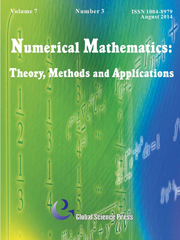Article contents
A Conservative Formulation and a Numerical Algorithm for theDouble-Gyre Nonlinear Shallow-Water Model
Published online by Cambridge University Press: 10 November 2015
Abstract
We present a conservative formulation and a numerical algorithm for thereduced-gravity shallow-water equations on a beta plane, subjected to a constantwind forcing that leads to the formation of double-gyre circulation in a closedocean basin. The novelty of the paper is that we reformulate the governingequations into a nonlinear hyperbolic conservation law plus source terms. Asecond-order fractional-step algorithm is used to solve the reformulatedequations. In the first step of the fractional-step algorithm, we solve thehomogeneous hyperbolic shallow-water equations by the wave-propagation finitevolume method. The resulting intermediate solution is then used as the initialcondition for the initial-boundary value problem in the second step. As aresult, the proposed method is not sensitive to the choice of viscosity andgives high-resolution results for coarse grids, as long as the Rossbydeformation radius is resolved. We discuss the boundary conditions in each step,when no-slip boundary conditions are imposed to the problem. We validate thealgorithm by a periodic flow on an f-plane with exactsolutions. The order-of-accuracy for the proposed algorithm is testednumerically. We illustrate a quasi-steady-state solution of the double-gyremodel via the height anomaly and the contour of stream function for theformation of double-gyre circulation in a closed basin. Our calculations arehighly consistent with the results reported in the literature. Finally, wepresent an application, in which the double-gyre model is coupled with theadvection equation for modeling transport of a pollutant in a closed oceanbasin.
Keywords
MSC classification
- Type
- Research Article
- Information
- Numerical Mathematics: Theory, Methods and Applications , Volume 8 , Issue 4 , November 2015 , pp. 634 - 650
- Copyright
- Copyright © Global-Science Press 2015
References
- 2
- Cited by


